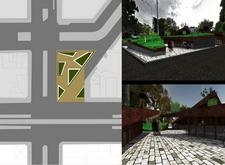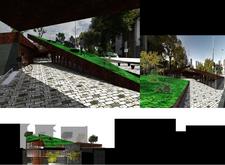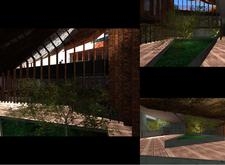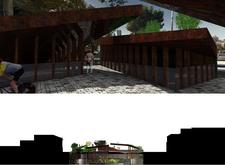5 key facts about this project
### Overview
Located within a contemporary urban context, the design features a multifaceted space characterized by a blend of natural and built elements. The intent focuses on community engagement and sustainability, providing an area that facilitates social interaction while challenging traditional architectural conventions.
### Spatial Organization
The design emphasizes openness and connectivity through an organic layout that incorporates triangular forms to provide both shelter and an inviting atmosphere. This configuration encourages exploration, enhancing user movement throughout the space. The interplay between hard and soft landscaping supports multifunctionality, catering to pedestrian traffic, social gatherings, and access to nature.
### Material Selection and Sustainability
The choice of materials reflects a commitment to durability and environmental integration. Key materials include:
- **CorTen Steel**: Selected for its weathered appearance and resilience, contributing to the overall aesthetic while requiring minimal maintenance.
- **Concrete**: Utilized for its structural capacity and modern texture, enhancing the space's industrial character.
- **Glass**: Incorporated strategically to promote transparency, enabling visual connections between indoor and outdoor areas while maximizing natural light exposure.
- **Paving Stones**: The textured finish aims to improve the pedestrian experience, creating a tactile connection with the site.
- **Green Roofs and Plantings**: These features not only promote biodiversity but also enhance insulation and aesthetic value, allowing the structure to harmonize with its surroundings.
The design employs green architecture principles, utilizing permeable surfaces to enhance water drainage and mitigate the urban heat island effect, while the open layout accommodates diverse uses, from recreational activities to public events. The thoughtful integration of transparent elements fosters visual continuity and fluid transitions, reinforcing community connectivity.






















































